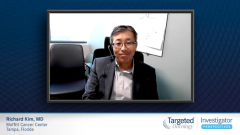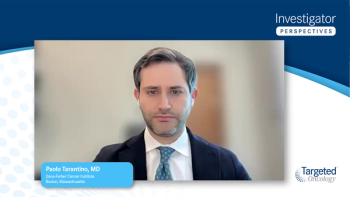
Approaching the Identification and Management of HCC
Expert Richard Kim, MD, reflects on the nature of HCC, particularly the challenges inherent in diagnosis and management.
Episodes in this series
Richard Kim, MD: As most of us know, HCC [hepatocellular carcinoma] is an aggressive tumor that typically starts in the setting of liver cirrhosis. In the United States, the incidence is around 42,000 cases per year. If you look at the data, it’s lumped in with the primary liver cancers along with intrahepatic cholangiocarcinoma, understanding that the bulk of it is primary liver cancer. For most of the patients who develop HCC, there are certain risk factors. For example, if you look at who’s most commonly affected, males tend to be more affected than females at a ratio of 3:1. It tends to be more prevalent in the Asian population and the African American population, most likely due to some of the risk factors they carry.
The risk factors most commonly known that can cause liver cirrhosis—most HCC occurs in the setting of liver cirrhosis—the common risk factors, at least in the United States, include hepatitis C. They include what we call nonalcoholic fatty liver, which is one of the most common risk factors evolving. Diabetes and obesity are 2 other common risk factors. In Asia, the most common risk factor we see is hepatitis B, which can potentially lead to HCC. Overall, the prognosis for liver cancer is not very good, and if you look at the data, the incidence and the mortality rates are very similar.
Obviously treatment will depend upon early detection. If you have any of those risk factors I mentioned, you definitely should be seen by your primary care physician or hepatologist so you can undergo screening. Hepatologists have their own guidelines, if you have hepatitis B or hepatitis C, on how often you should undergo screening with ultrasound or with laboratory tests. I think that’s a very important point.
One of the challenges in diagnosing and managing HCC is that depending on where you practice, you may not see a lot of hepatocellular carcinoma. I think that’s one of the challenges. If you don’t see a lot of the patient population, then it may be difficult to manage. Having said that, unfortunately, the bulk of patients will present with advanced-stage disease. Only 20% to 30% of patients will present in early stages. Now, if you look at the overview of how we manage hepatocellular carcinoma, there are only 2 ways of curing the disease: one is liver resection, and the other is liver transplant. Once again, that only accounts for about 20% to 30% of the patients we see.
The rest of the patients, unfortunately, are not curable. This is where we truly need a multidisciplinary approach. At our tertiary medical center, we have a tumor board, for example. We have a lot of specialties involved in caring for those patients, including oncologists, surgeons, interventional radiologists, pathologists, and sometimes even radiation oncologists. I think one of the hurdles we face in the community is that there is not a team approach, there’s not a multidisciplinary approach in some cases. I think this is where it’s important, if you see anybody who you suspect has or was diagnosed with hepatocellular carcinoma to refer those patients to a tertiary center where they can truly be treated with a multidisciplinary approach.
Regarding the unmet needs at this time, in terms of the systemic treatment perspective, we’ve come a very long way in terms of treating a patient with advanced disease. Sorafenib used to be the only TKI [tyrosine kinase inhibitor] that was available. However, with the recent approval of atezolizumab and bevacizumab based on the IMbrave150 study, that has taken over. Now, we don’t know what to do afterward. In the case that atezolizumab and bevacizumab fail, what do you use in the second line? That’s a truly unmet need. The other area of unmet need is, can we move this combination of atezolizumab and bevacizumab into an earlier setting, for example, in a patient with BCLC [Barcelona Clinic Liver Cancer] stage B? These are patients with a multifocal hepatocellular carcinoma, just within the liver. Can you move atezolizumab and bevacizumab up to see if they could be used in combination with local therapy, or by themselves in this setting, and get the same efficacy? Those are 2 of the unmet needs at this time.
Transcript edited for clarity.







































